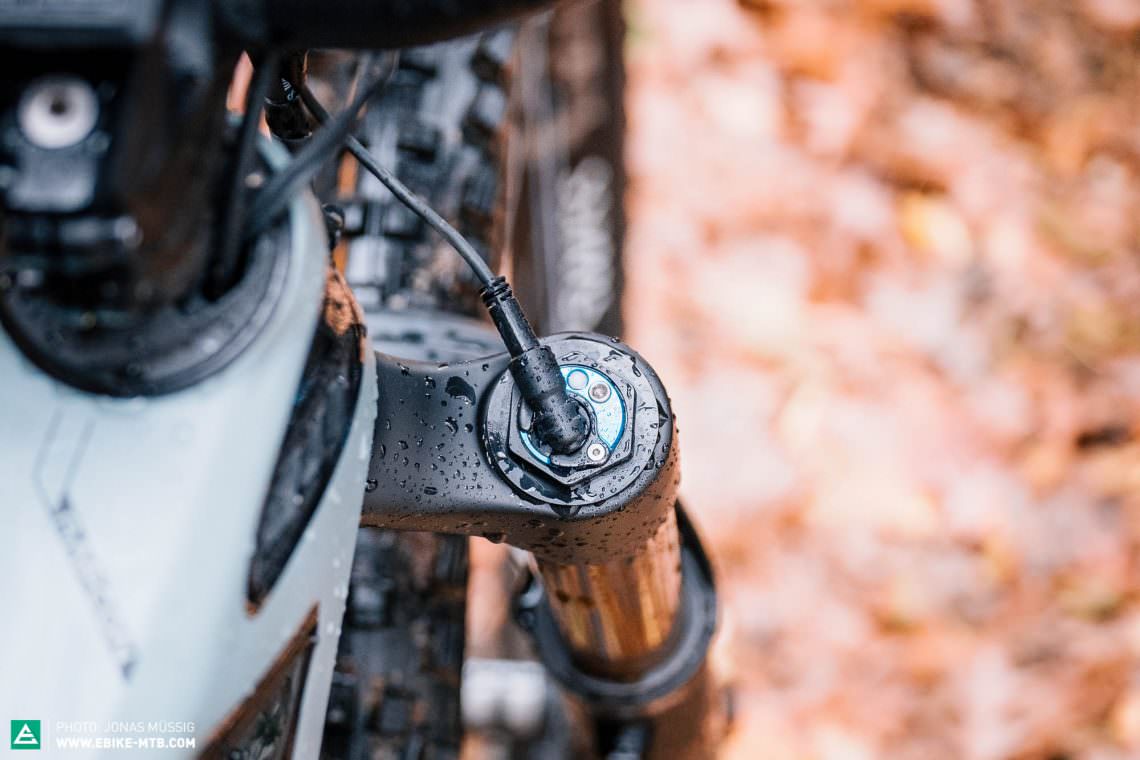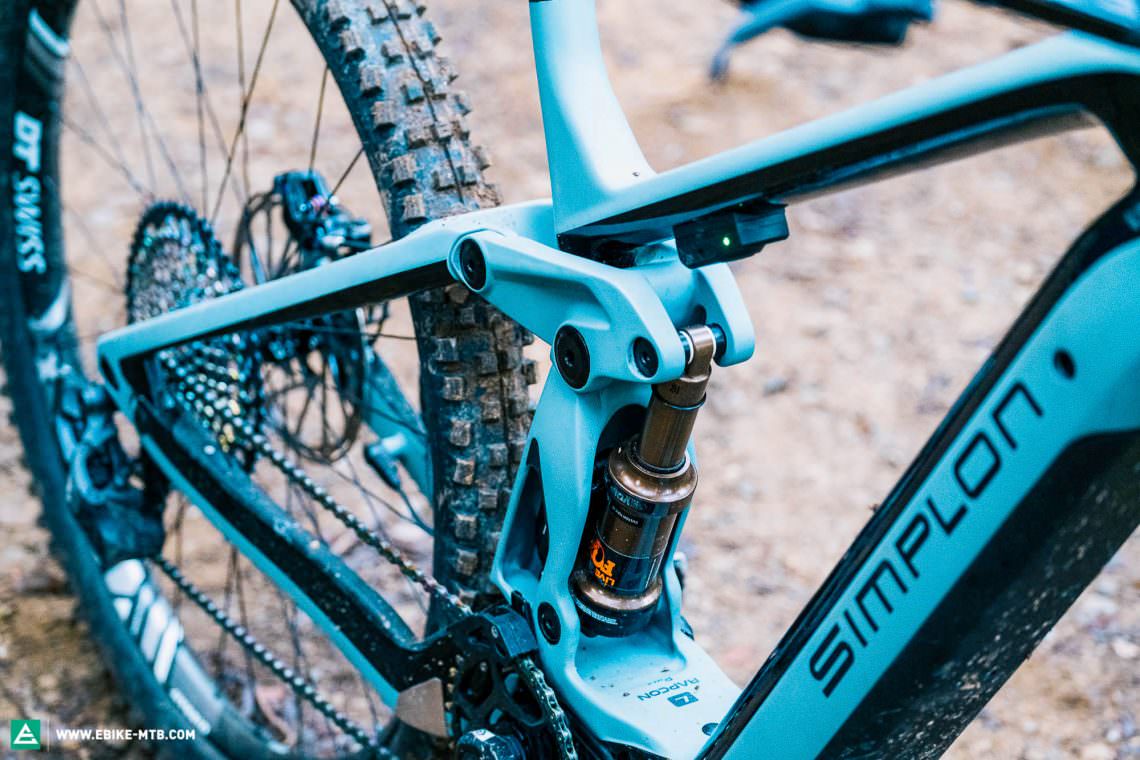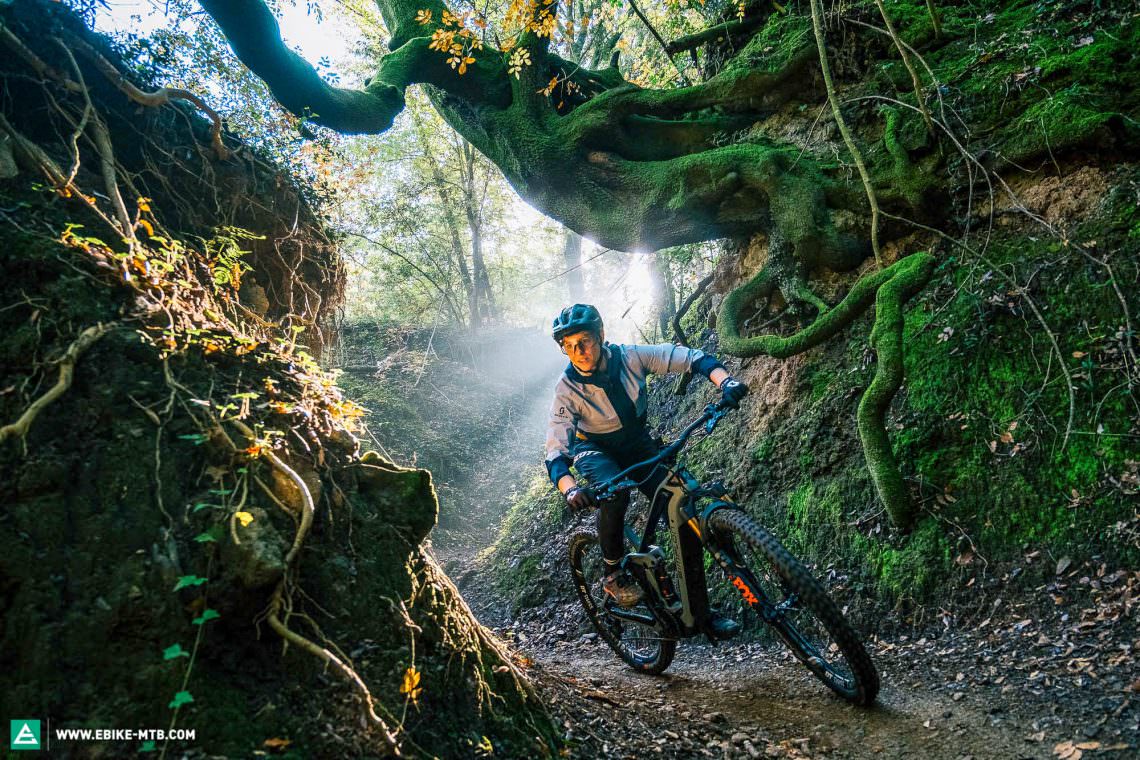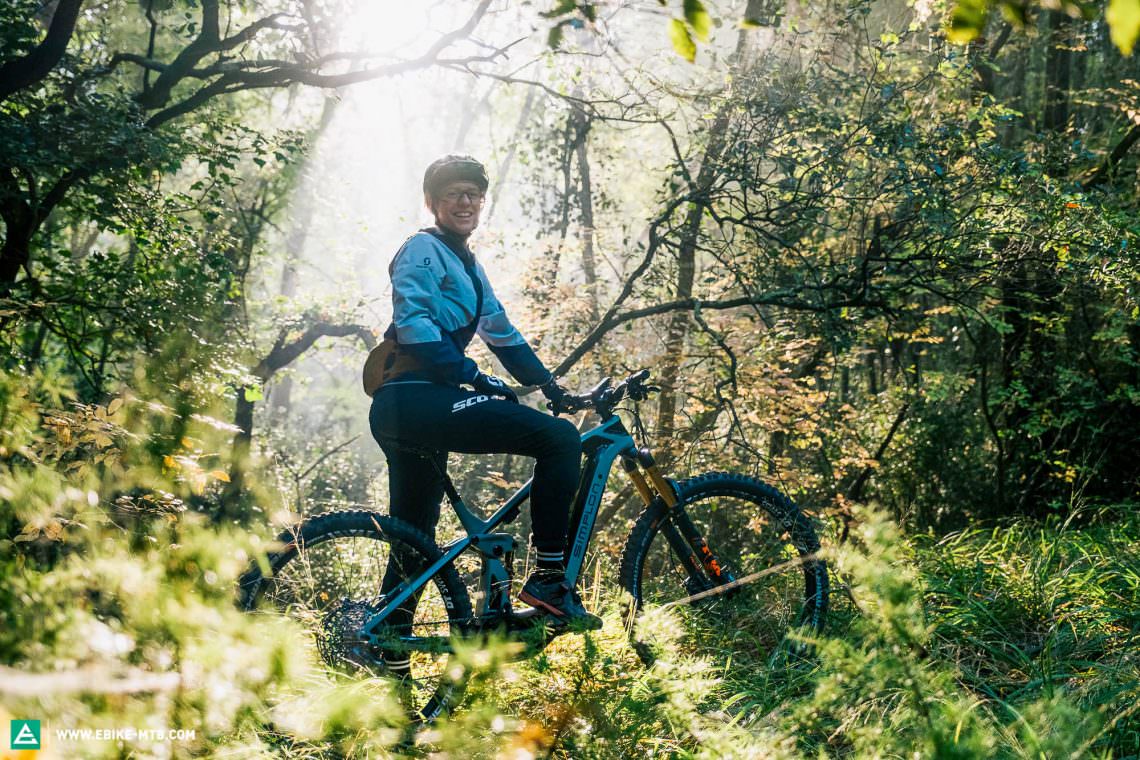We have tested the new FOX E-Live Valve suspension for eMTBs. Can the electronic suspension truly deliver more performance and comfort on the trail or does it just make your ride more complicated? You can find the answers here.
FOX E-Live Valve encompasses an electronically controlled suspension system. While this type of system is nothing new, being widespread in motorsport and with FOX already offering Live Valve for both analog mountain bikes and all-terrain vehicles. However, what’s new here is its application to eMTBs. The E-Live Valve system decides automatically when to open or close your suspension and ensures you won’t ever forget to turn off the lockout before your descent.

What is FOX E-Live Valve?
Dialling in the optimal suspension settings is hardly ever about maximising the performance of individual parameters but instead about finding a considered balance between all the different parameters. Setting up compression damping involves a compromise between stiff and efficient pedalling characteristics and supple performance for grip and comfort. But what if that didn’t have to be the case? With their E-Live Valve technology, the engineers at FOX have created a suspension technology that attempts to remove that compromise from the equation.
The technology adjusts the compression damping of the fork and shock based on the current trail and riding conditions. In contrast to more advanced units found in motorsport, the adjustment isn’t made in continuous steps but switches between two modes: open or closed. That happens automatically meaning you don’t have to spend any time thinking about which suspension mode you’re in or flicking a lockout switch, no longer present with the system anyway, on your fork or shock. FOX E-Live Valve recognises the riding situation and makes sure that you’re always in the right suspension mode.

Which components make up the system?
The key requirement for the E-Live Valve system is that you have an ebike equipped with the current Bosch Performance CX motor and Kiox display. In addition, the ebike itself must be E-Live Valve compatible. Several models from Moustache, SIMPLON and SCOTT are furnished with suitable mounts already. The system controller is installed in a fixed place on the frame, while the rear end has to be designed to accommodate a sensor close to the axle. A further sensor sits on the fork crown.



For the E-Live Valve system, FOX’s usual candidates like the FOX 36 or 38 come to play for the forks. Damping is based on a modified FIT4 cartridge with the usual adjustments for low-speed compression and rebound. However, it uses a magnetic valve that is opened or closed by the controller. The shock has been developed specifically for the system and is a new addition to the FOX lineup. It also allows adjustment of low-speed compression, rebound and has a similar magnetic valve. The controller and magnetic valves are both powered by the Bosch battery, meaning no other power is required for the E-Live Valve system. The system can be set up via the Kiox display or the Live Valve Bike app.

The E-Live Valve suspension results in two extra cables running to the fork and an additional one to the rear sensor in the frame. The necessary evil of additional cables was unobtrusively and neatly solved on the rear end of our SIMPLON Rapcom Pmax test bike. Unfortunately, at the front cables and plugs dangle before disappearing into the stem. Manufacturers will have to come up with neater solutions to deal with all the additional cables. In contrast, for the controller on the underside of the top tube, cable management, or rather the lack of any cables, is absolutely on point. The top tube of the SIMPLON is completely free of visible cables.




How does it work?
The sensors on the fork and rear end run at a refresh rate of 1 kHz to determine the current riding conditions and communicate the movements of the front and rear to the controller. That includes hits from roots, rocks, braking bumps as well as the current status and angle of the ebike, whether it’s level, going uphill, downhill or even in freefall after a drop or jump. Based on the gathered data, the controller determines the current riding conditions you find yourself in. Depending on the situation, it decides, based on the E-Live Valve mode setting, whether to open or close the fork, shock or both together. While it takes five long sentences to explain this process, FOX claim it takes the controller just 3 ms to open or close the fork and shock after a hit.

After an impact, the controller decides how long the suspension should stay open based on the selected mode and the input it received from the sensors. If no further impacts occur, the controller firms up the suspension again. The processing in the controller happens completely in the background, with only the flashing status indicator and audible clack of the magnetic valves letting you know that the system is active.
FOX E-Live Valve setup
E-Live Valve setup is much the same as that required for conventional suspension. If you’re still a little unsure, make sure to check out our detailed setup guide. To make sure the suspension remains open during setup, sag, rebound and compression damping need to be set in Open mode. The low-speed compression damping is adjusted with a 3 mm Allen key on both the fork and shock. Unfortunately, on our test bike, the shock adjustment was awkwardly placed and only accessible with the ball head of a long tool. A blessing in disguise? E-Live Valve means adjustments only had to be made once, after which the shock was left completely alone.


With the mechanical part done, only the electronics remain. The menu of the Kiox display lets you select different suspension settings, which include Open, Comfort, Sport, Firm and Commute. With each next suspension mode, an even harder hit or even steeper terrain is required before the suspension opens up. On top of that, the time for which the suspension remains open is also reduced. The slope and inferred riding situation also influence when and how the long suspension is open for, resulting in a different suspension response in each mode.


In addition, FOX’s Live Valve Bike app lets you fine-tune the individual modes. Bump sensitivity can be adjusted in five-steps to determine how big the initial hit needs to be for the suspension to open. Nonetheless, the basic character of the riding modes remains the same. Even with the highest bump sensitivity, Firm mode won’t end up softer than Comfort mode in it’s firmest setting.
FOX E-Live Valve tested on the trail
For this suspension test, we took a seat aboard the SIMPLON Rapcon Pmax. For all the details on this ebike, you should take a closer look at our 2020 eMTB group test, where the Rapcon Pmax, in a different build, shone with its versatile utility from Alpencross to bike parks.

23.74 kg (size L) | Manufacturer’s website
Our E-Live Valve test bike comes with a FOX 38 fork and the FOX Float Live Valve shock mounted on the frame. Front and rear, travel has shrunk to 150 mm and the bike rolls on 29″ wheels. The rest of the spec is chosen for trail fun, though like its predecessor, this ebike is suited to more than just blasting tracks, offering great all-round performance.

After the first few metres, a fascinating ride feel quickly reveals itself. On the flats, it feels like the SIMPLON doesn’t waste a single watt to a bobbing rear end. It efficiently and purposefully marches forwards but when you hit roots or other obstacles, the suspension remains active and sucks up the hits. That efficiency is so pronounced, that the E-Live Valve system ends up saving more battery for riding than it consumes itself.

If you’re climbing in a more supportive mode like Firm or Sport, the motor feels more powerful than on similar ebikes with standard suspension. E-Live Valve keeps the suspension higher, resulting in a better riding position and preventing the shock from sinking into its travel. That also means there’s more pressure on the front to glue the wheel to the ground, ensuring more precise line choices and better handling. If it’s not possible to steer the ebike around something, the powerful propulsion just lets you muscle over edges and obstacles. With the suspension deactivated, every stroke of the pedals is directly converted into propulsion but hit something and the fork opens up quickly enough to catch the bump and lift the front wheel over the edge. At the rear, this effect is even more noticeable and results in high levels of traction for the otherwise firm suspension. For example, if the front rolls over a slippery root, it’s a comparative eternity for the system before the rear wheel reaches it, allowing E-Live Valve to open up the suspension and roll over, rather than bounce off, the obstacle.

When the trail points back down the orientation sensor in the controller immediately knows that you’re heading downhill. Here, E-Live Valve has an enormous influence on the character of the ebike. If you’re riding in the Firm or Sport mode, the suspension doesn’t remain open for very long at a time, providing lots of support that you can make use of. On flowing and jump-heavy trails, pumping and active riding through berms and rollers lets you generate a lot of speed. On fast direction changes, the ebike doesn’t tend to slump into its travel resulting in a responsive ride. If you hit a jump, you can work the suspension hard without losing any pop and you get noticeably more air. Thankfully, if you happen to overshoot the landing you won’t need to worry as the controller senses your freefall shortly after takeoff and opens up the suspension ready for landing.

While the intelligent FOX suspension works excellently on flat flow trails, its limitations become more obvious when moving over to rougher terrain. If you’re riding in Firm mode and transition from a freshly shaped section of trail to a rock garden or berm with pronounced braking bumps, the initial impact is noticeably transmitted to your hands. The first hit at the rear and all subsequent impacts at the front are absorbed as expected by the now open suspension. That means setup via the FOX app requires a change in approach. If you use the harder modes like Firm to generate the most support on flow and jump trails, you should set the bump sensitivity to the most sensitive setting so that the suspension opens up quickly in response to obstacles and rough sections, without the fundamental character of the mode disappearing.

Ideally, it would be possible to change the suspension mode via controls on the bar remote similar to the speed with which it is possible to change motor assistance modes. Unfortunately, the suspension setting is in a sub menu and changes have to be confirmed each time. That means that during the fervour of riding, it’s not possible to set the suspension to Open quickly enough to respond to changing terrain. For natural trails and singletrails without built-up jumps, it’s worth leaving the ebike in Comfort or Open mode. That offers the most traction over root carpets and other similar terrain that nature has to offer.

If you want to use E-Live Valve to set best times on high-speed sections, you might reach the limits of the damper. Very fast ebikers would benefit from more high-speed compression but this isn’t adjustable on the FIT4 damper. You’ll have to try and use volume spacers to find a fitting setup instead. However, ultimately the fork can’t match the sensitive handling of the FOX 38 with its superior GRIP2 cartridge, even in Open mode.
Victory parade for electronic suspension? Costs and aftermarket options for FOX E-Live Valve
With its strong debut, the question of whether in one or two years electronically controlled suspension will become common fare on eMTBs is inevitable. The answer: probably not. If nothing else, the high price for E-Live Valve is an obstacle that already represents a significant barrier to entry for the Live Valve found on analog bikes. For a complete build, you’ll have to factor in just under € 1,800 for the suspension and that’s the cheaper option. Retrofitting the system is theoretically possible but the cost will be significantly higher. In addition, the system also requires a compatible frame which adds costs to production which end up benefitting only a limited number of end-users. The ebike has to have mounts on the frame for the controller and sensor at the rear as well as offering appropriate cable routing. On top of that, the retrofitted ebike has to be calibrated so that it knows when it is level. That said, the calibration process isn’t particularly complicated and can be done easily yourself on complete builds should the sensor ever run amok.

Conclusion
With E-Live Valve, FOX have created an impressive system that has the potential to change how and where we ride ebikes. Uphill, it provides the suspension with unanticipated climbing qualities and makes sluggish eMTBs agile through corners. At the same time, the suspension expands the range of application enormously and makes it possible to commute efficiently, ride an Alpencross or tackle an Enduro descent all on the same bike. Currently, there are still improvements to be made regarding integration and the awkward mode changes and if you’re looking for perfectly tuned suspension for the downhills, you’ll be better served by traditional options. However, everyone else can benefit significantly from electronic suspension.
More information at ridefox.com
Did you enjoy this article? If so, we would be stoked if you decide to support us with a monthly contribution. By becoming a supporter of E-MOUNTAINBIKE, you will help secure a sustainable future for high-quality cycling journalism. Click here to learn more.
Words: Rudolf Fischer, Felix Stix Photos: Valentin Rühl, Jonas Müssig









